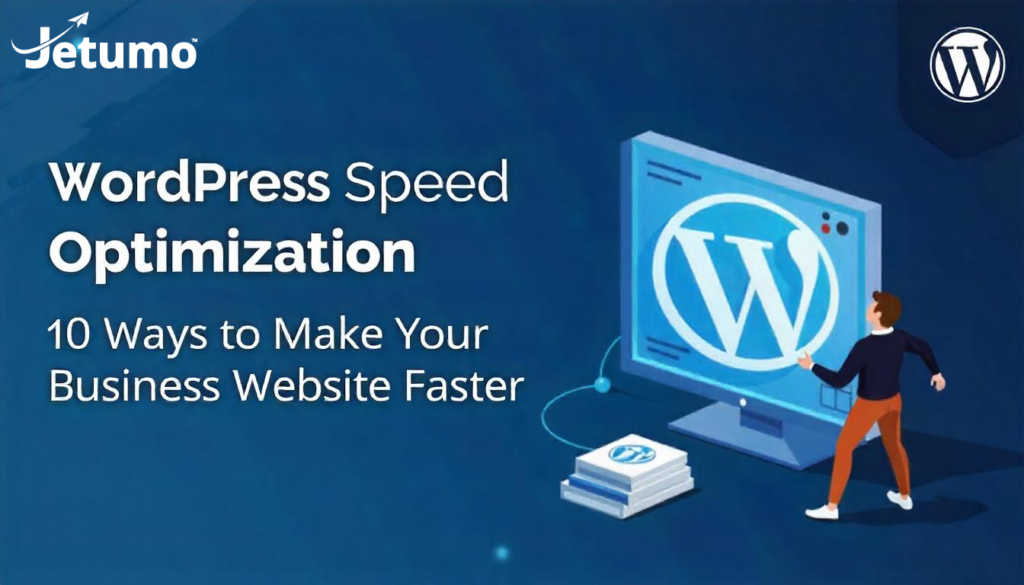Having a website is essential for small businesses today, but how do you know if it’s actually working for you? Many small business owners invest in creating a WordPress website but have no idea if it’s performing well or helping their business grow. This article will show you practical website performance monitoring for small business techniques that don’t require technical expertise but will help you understand if your website is truly supporting your business goals. With the right monitoring tools and metrics, you can track your website’s performance, identify issues before they impact your customers, and ensure your online presence is delivering real business results.
Why Website Performance Monitoring for Small Business Matters
Your website is often the first impression potential customers have of your business. If it’s slow, unreliable, or difficult to use, you’re potentially losing customers without even realizing it. Website performance monitoring for small business isn’t just about technical metrics—it’s about understanding how your website contributes to your actual business results and ultimately affects your user experience.
Research shows that 47% of visitors expect a website to load in under 2 seconds, and 40% will abandon a site that takes more than 3 seconds to load. For small businesses, every potential customer counts, making website performance a direct factor in your bottom line.
Effective monitoring helps you identify performance issues before they impact your business. By tracking key metrics and setting up alerts for potential problems, you can ensure your website remains a valuable asset rather than a liability. The best website monitoring approaches combine both technical performance tracking and business impact measurements.
The Real Cost of Poor Website Performance
Poor website performance isn’t just a technical issue—it has real business consequences:
- Lost sales opportunities when potential customers leave before converting, directly impacting your conversion rate
- Damaged brand reputation when visitors have a frustrating user experience
- Wasted marketing spend when paid traffic arrives at an underperforming site
- Lower search engine rankings as Google prioritizes faster, more stable websites in their SEO algorithms
- Higher bounce rates as visitors abandon slow-loading pages
- Reduced ROI on all your digital marketing efforts
Without proper monitoring tools to track these issues, small businesses often remain unaware of how much revenue they’re losing due to website performance problems.
Learn more about how website speed affects your business
Essential Website Performance Metrics for Small Business Owners
Instead of drowning in technical jargon, focus on these straightforward performance indicators that directly impact your business. The right monitoring tools can help you track these metrics without requiring technical expertise.
1. Load Time: How Fast Is Your Website?
Website load time is how long it takes for your pages to become fully visible and usable by visitors. This is one of the most critical metrics in website performance monitoring for small business owners. Slow loading speed is one of the main factors that can slow down your site and drive away potential customers.
How to check it:
- Use Google PageSpeed Insights – a free tool that analyzes your website speed and provides a score from 0-100
- Test your website from GTmetrix to get detailed loading information
- Try Pingdom’s performance testing tools which offer a free trial for comprehensive speed analysis
What to monitor:
- Overall page load time
- Time to First Byte (TTFB)
- Core Web Vitals (Google’s specific performance metrics)
- Interaction to Next Paint (INP)
- Individual element loading times
What’s good:
- Mobile page load: Under 3 seconds
- Desktop page load: Under 2 seconds
- PageSpeed score: Above 70
If your site takes longer to load, you may need to optimize your WordPress site’s speed.
Tools like Pingdom and New Relic provide detailed performance metrics that can help identify specific elements slowing down your website’s performance.
2. Uptime: Is Your Website Actually Available?
Uptime measures the percentage of time your website is accessible to visitors. Even brief periods of downtime can cost your business valuable opportunities. Website uptime monitoring is essential for ensuring your website is available to customers around the clock.
How to check it:
- Use a free monitoring tool like UptimeRobot
- Set up alerts to notify you if your site goes down
- Consider tools like Pingdom that offer both uptime monitoring and performance testing
- Many monitoring services can check your website in real time and send instant notifications
What to monitor:
- Overall uptime percentage
- Patterns in downtime (specific times of day/week)
- Response times during high-traffic periods
- Server response codes (to identify specific types of errors)
What’s good:
- 99.9% uptime or better (less than 43 minutes of downtime per month)
- Immediate notification of any outages
- Consistent response times even during traffic spikes
Web monitoring tools can help track these metrics automatically, ensuring your website remains available and functional. Your web hosting choice significantly impacts your website’s uptime reliability.
3. Mobile Responsiveness: How Does Your Site Look on Phones?
With over 60% of web traffic coming from mobile devices, your site needs to work perfectly on smartphones. Mobile performance is a critical aspect of website performance monitoring for small business success.
How to check it:
- Use Google’s Mobile-Friendly Test
- Test your site on your own phone and tablet
- Use synthetic monitoring tools that simulate mobile devices
- Set up real user monitoring to collect data from actual mobile visitors
What to monitor:
- Mobile loading speed (often slower than desktop)
- Touch element sizing and spacing
- Mobile navigation functionality
- Image scaling and visibility
- Form usability on small screens
What’s good:
- “Mobile-friendly” result from Google’s test
- Mobile page load under 3 seconds
- Text that’s readable without zooming
- Buttons and links that are easy to tap
- No horizontal scrolling required
- Consistent experience across different devices and screen sizes
Mobile optimization directly impacts both user experience and SEO performance, making it an essential component of website performance monitoring.
4. Security Status: Is Your Website Protected?
Website security is a critical aspect of performance that many small business owners overlook until it’s too late.
How to check it:
- Verify your SSL certificate is active (your URL should start with “https://”)
- Use Sucuri SiteCheck to scan for malware
- Check for WordPress security warnings when you log in
What’s good:
- Active SSL certificate
- Regular security updates
- No malware detected
- Security measures in place
Business Impact Metrics: Does Your Website Drive Results?
Technical performance is just the foundation. These business-focused metrics tell you if your website is actually working for your small business:
1. Conversion Rate: Are Visitors Taking Action?
Conversion rate measures the percentage of visitors who complete a desired action on your website, such as making a purchase, filling out a contact form, or signing up for a newsletter.
How to check it:
- Set up Google Analytics 4 (GA4) with conversion goals
- Review the “Conversions” section in your analytics dashboard
What’s good:
- Average conversion rates vary by industry, but aim for at least 2-3%
- Improvement over time is more important than hitting a specific number
2. Bounce Rate: Are People Leaving Immediately?
Bounce rate shows the percentage of visitors who leave your site after viewing only one page. A high bounce rate often indicates visitors aren’t finding what they need.
How to check it:
- Look at the “Engagement” metrics in GA4
- Pay special attention to your homepage and main landing pages
What’s good:
- Below 70% for most small business websites
- Visitors viewing multiple pages per session
3. Traffic Sources: Where Are Your Visitors Coming From?
Understanding how people find your website helps you invest in the right marketing channels.
How to check it:
- Review the “Acquisition” section in Google Analytics
- Look at which sources bring the most valuable traffic
What’s good:
- Diverse traffic sources (search, direct, social, referral)
- Increasing organic search traffic
- Traffic sources that align with your marketing efforts
4. Customer Journey: How Do Visitors Move Through Your Site?
Understanding how visitors navigate your website helps identify both successful paths and potential roadblocks.
How to check it:
- Use the “Behavior Flow” report in Google Analytics
- Note which pages have high exit rates
What’s good:
- Logical progression through your site
- Multiple page views per session
- Low exit rates on key conversion pages
What Types of Website Monitoring Tools Are Available for Small Businesses?
Before setting up your monitoring system, it’s helpful to understand the different types of website monitoring tools available to help small businesses track performance:
1. Synthetic Monitoring vs. Real User Monitoring: What’s the Difference?
Synthetic monitoring tools simulate user interactions with your website from various locations and devices. These tools are great for:
- Regular benchmark testing under controlled conditions
- Testing performance before launching new features
- Identifying issues before they affect real users
- Monitoring critical paths (like checkout processes)
Real user monitoring (RUM) captures data from actual visitors to your website, providing insights into:
- How real users experience your site
- Which devices and browsers your audience uses
- Geographic performance variations
- User behavior patterns that affect performance
The best website monitoring approach typically combines both methods for comprehensive coverage.
2. Free vs. Paid Monitoring Tools: What’s Right for Your Business?
Many website monitoring tools offer free trials or limited free plans that can be sufficient for small businesses:
Popular free or freemium options:
- Google PageSpeed Insights (performance testing)
- Google Search Console (SEO performance)
- UptimeRobot (basic uptime monitoring)
- Pingdom (limited free tests with paid plans)
Paid tools with more capabilities:
- New Relic (comprehensive performance monitoring)
- GTmetrix Pro (detailed performance analysis)
- Pingdom (continuous monitoring with alerts)
- Datadog (for more complex websites)
Most paid tools offer a 30-day free trial, allowing you to test their features before committing.
How to Set Up Basic Website Performance Monitoring for Small Business
You don’t need complex tools or technical knowledge to keep track of your website’s performance. Here’s a simple monitoring system any small business owner can implement:
1. Set Up Google Analytics 4 for User Behavior Tracking
Google Analytics provides rich data about your visitors and how they interact with your website, making it an essential tool for monitoring your website’s performance.
Simple setup steps:
- Create a Google Analytics account if you don’t have one
- Follow the setup wizard to add your website
- Install the GA4 tracking code on your WordPress site (using a plugin like MonsterInsights makes this easy)
- Set up basic goals to track conversions
- Enable enhanced measurement to track more user interactions automatically
2. Implement Regular Performance Checks to Keep Track of Your Website
Create a simple monthly website checkup routine to ensure your site runs smoothly:
Basic monthly checklist:
- Run a speed test using PageSpeed Insights
- Check your uptime percentage using a monitoring tool
- Review your security status and SSL certificate validity
- Test key functions (forms, payments, etc.)
- Verify mobile display on various devices
- Check for broken links that might affect user experience
- Monitor Core Web Vitals through Google Search Console
3. Create a Simple Performance Dashboard for Easy Monitoring
Combine your most important metrics in one place for easy monitoring:
What to include:
- Current month’s traffic
- Conversion rate
- Average page load time
- Bounce rate by device type
- Uptime percentage
- Top-performing pages
- Key issues requiring attention
Several WordPress plugins can help create simple dashboards, or you can use Google Data Studio (now called Looker Studio) for a more visual approach. Many cloud-based monitoring tools also offer customizable dashboards that aggregate multiple website metrics.
Common Website Performance Issues and How to Fix Them
Even with regular monitoring, you may encounter performance issues. Here are common problems small business websites face and how to address them:
1. Slow Loading Times
Potential causes:
- Large, unoptimized images
- Too many plugins
- Poor quality hosting
- Lack of caching
Simple fixes:
- Optimize and compress images
- Remove unnecessary plugins
- Implement caching
- Consider upgrading your hosting
2. Mobile Display Problems
Potential causes:
- Non-responsive theme
- Large images pushing layouts
- Text too small on mobile screens
Simple fixes:
- Switch to a fully responsive WordPress theme
- Check mobile preview before publishing content
- Use larger font sizes (minimum 16px)
3. Security Vulnerabilities
Potential causes:
- Outdated WordPress core, themes, or plugins
- Weak passwords
- Lack of security measures
Simple fixes:
- Keep everything updated
- Use strong passwords and two-factor authentication
- Add a security plugin
- Follow basic website security practices
4. Low Conversion Rates
Potential causes:
- Unclear calls to action
- Complicated forms
- Lack of trust signals
- Poor user experience
Simple fixes:
- Make your calls to action obvious and compelling
- Simplify forms to only essential fields
- Add testimonials and trust indicators
- Improve navigation and user flow
When to Get Help with Website Performance Monitoring
While many aspects of website performance monitoring for small business can be handled independently, sometimes professional assistance is warranted:
Signs It’s Time for Professional Help
- Persistent speed issues despite basic optimization
- Recurring security problems or a suspected breach
- Significant traffic but very few conversions
- Technical alerts you don’t understand
- Your website is crucial to your business but underperforming
What to Look for in a WordPress Support Partner
When seeking help with your website performance:
- Look for providers who explain things in plain language
- Avoid those who use technical jargon to confuse you
- Choose partners who focus on business outcomes, not just technical metrics
- Find someone who provides proactive monitoring, not just reactive fixes
How Can You Use Monitoring Data for Performance Optimization?
Website performance monitoring is only valuable if you use the insights to improve your site. The data you collect should guide your performance optimization efforts.
Turning Insights into Action: A Simple Process
Follow this simple process to make the most of your monitoring tools and data:
- Gather data through your monitoring tools
- Identify the biggest issues impacting your business goals
- Benchmark your performance against industry standards
- Prioritize fixes based on business impact and difficulty
- Make one improvement at a time and measure the results
- Set up alerts for any performance regressions
- Repeat the process focusing on the next priority
This continuous improvement approach ensures your website keeps getting better without overwhelming you with changes.
Common Performance Bottlenecks to Watch For
Your monitoring tools will likely identify some of these common issues:
- Large, unoptimized images slowing down page load times
- Excessive plugin usage adding unnecessary code bloat
- Missing or improper caching forcing repeat downloads
- Render-blocking resources delaying visible page content
- Server response times indicating hosting limitations
- Third-party scripts adding unpredictable delays
Addressing these common bottlenecks often leads to immediately improved performance and better user experience.
What Are the Best Practices for Ongoing Website Performance Monitoring?
To maintain optimal performance over time, follow these website performance monitoring best practices:
- Schedule regular reviews – Set a consistent schedule for reviewing performance metrics
- Document performance changes – Keep track of when changes were made and their impact
- Test after updates – Always check performance after WordPress updates or adding new plugins
- Monitor after traffic spikes – Check how your site performs during and after high-traffic periods
- Update your monitoring approach – As your business grows, your monitoring needs may change
- Combine automated and manual testing – Don’t rely solely on tools; periodically test as a real user would
Following these best practices helps ensure your website remains a valuable business asset rather than a liability.
Website Performance Monitoring for Small Business: Key Takeaways
Effective website performance monitoring doesn’t require technical expertise—it requires focus on what matters to your business:
- Focus on metrics that impact your business goals and user experience
- Use the right tools available to help track performance without technical knowledge
- Implement a simple monthly checkup routine to monitor website health
- Set up alerts for critical performance issues that could impact customers
- Address the biggest issues first based on business impact
- Consider the user experience above all else when prioritizing improvements
- Combine different types of website monitoring for comprehensive coverage
- Get help when needed for persistent issues that affect your website’s performance
Your website should be working for your business, not creating more work. By implementing these straightforward monitoring practices, you’ll ensure your WordPress site is performing at its best and truly supporting your small business goals.
Need help monitoring and optimizing your WordPress website? Jetumo’s managed WordPress hosting includes performance monitoring, optimization, and expert support, so you can stop worrying about technical details and focus on growing your small business. Learn more about our services designed specifically for small business owners like you.



